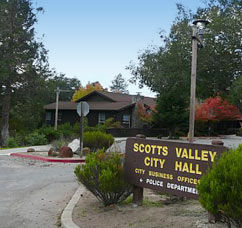While finding the current fiscal year budget tracking close to expectations, the Scotts Valley City Council discussed at length how to avoid a “financial cliff” projected in the years to come. At the regular city council meeting on March 7, council members considered a mid-year review of the FY 2017/18 budget, and discussed how the City will handle a projected budget deficit of more than $2 million by FY 2024/25.
Council members scrutinized the assumptions, projections and strategies recommended in a Fiscal Sustainability Plan that shows if corrective actions are not taken in the next few years, the city’s general fund reserve will be exhausted by FY 2022/23, and the city will be running a deficit of over $2.4 million by FY 2026/27.
“While we have some tough fiscal waters to navigate in the not so distant future, staff has proactively identified several approaches and strategies for further discussion to address our budget challenges head on,” said City Manager Jenny Haruyama via email to The Press Banner.
Driving the projected deficits is the expiration of Measure U, a half cent sales tax approved by Scotts Valley voters in 2013, scheduled to expire in 2022. Measure U increased the sales tax from 8.25% to 8.75% in Scotts Valley, increasing the city’s “general purpose” revenue by about $1.2 million each year for eight years. Coupled with the expiration of Measure U are increasing pension costs for city staff, projected to increase by about $1 million through FY 2021/22, and up to $1.9 million by 2024/25.
City staff have been working with a private consulting firm, Management Partners, Inc., located in San Jose, to assist with the analysis and recommendations of the Fiscal Sustainability Plan (FSB). At the March 7th city council meeting, Steve Toler, Senior Manager with Management Partners presented various scenarios to increase revenues, reduce costs and maintain service delivery in light of the projected budget deficits.
“The council gave clear direction back in December that they wanted to maintain or improve service levels in the fiscal sustainability plan,” Steve Toler said. This basically leads to an enhanced focus on maintaining and improving revenue sources, which is to say, taxes and fees, according to Toler. “Council members have their eye on the ball, and are trying to stay ahead of this thing,” Toler said.
Toler makes clear that many cities across California are facing similar, long-term fiscal problems as most are facing the same pension cost increases recently announced by the California Public Employees Retirement System (CalPERS). In addition, cities have typically been catching up with deferred maintenance and improvements to various infrastructure systems, as well as trying to restore service levels to “pre-Great Recession” levels, according to Toler.
Following what were often emergency measures taken in the wake of the 2008 financial collapse and the “Great Recession” that followed, such as the voter-approved Measure U in Scotts Valley, the economic recovery has been slower and more uneven than expected, in terms of tax revenue for cities, Toler explained.
“Local governments have been trying to restore funding for services cut during the Great Recession, and have been working out ways for smarter, more efficient service delivery,” Toler said.
“In terms of cutting costs while trying to maintain service delivery,” Toler explains, “most of the low hanging fruit has already been picked. And yet the difference between on-going revenues and the rising cost of simply maintaining service levels is widening,” Toler said.
Toler explained the amount of property taxes apportioned to incorporated cities by the county property tax collector can vary quite widely. The statewide average is between 14 and 16 cents of every dollar paid in property taxes is transferred to incorporated city governments. Scotts Valley receives a very low property tax apportionment rate of only six and half cents per dollar of property tax paid to the County.
Ever since the passage Proposition 13 in 1978, a statewide initiative capping the amount of property taxes to one percent of the assessed value of the property, local governments have been forced to develop a variety of different revenue sources, such as fees for service, special assessments and voter –approved tax increases, to balance budgets. A key revenue source, especially for cities with a tourism industry, is the transient occupancy tax (TOT), a tax added to the cost of hotel rooms paid directly to the local government.
Scotts Valley has a TOT of 10 percent, compared to 11 per cent in both the city and county of Santa Cruz and Watsonville. Council members discussed the possibility of requesting voters to approve a hike in TOT to 12 percent, as early as the November, 2018 general election.
Council members also discussed how and when it may be appropriate to initiate voter approved tax measures, and ask voters to extend or possibly increase the half cent sales tax that is scheduled to expire in 2022.











